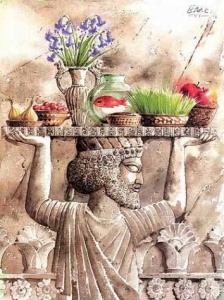Denoting “seven items beginning with the letter sin (S),” is one of the components of the rituals of the New Year’s Day festival observed by most Iranians.
The items are traditionally displayed on the dining cloth (sofra) that every household spreads out on the floor (or on a table) in a room normally reserved for entertaining guests.
The items symbolically correspond to seven creations and holy immortals protecting them. The Haft Sin has evolved over time, but has kept its symbolism. Traditionally, families attempt to set as beautiful a Haft Sīn table as they can, as it is not only of traditional and spiritual value, but also noticed by visitors during Nowrouz visitations and is a reflection of their good taste.

The items traditionally used are:
- Sabzeh – wheat, barley or lentil sprouts growing in a dish – symbolizing rebirth
- Samanoo – a sweet pudding made from wheat germ – symbolizing affluence
- Senjed – the dried fruit of the oleaster tree – symbolizing love
- Sīr – garlic – symbolizing medicine
- Sīb – apples – symbolizing beauty and health
- Somaq – summac berries – symbolizing (the color of) sunrise
- Serkeh – vinegar – symbolizing age and patience

Denoting “seven items beginning with the letter sin (S),” is one of the components of the rituals of the New Year’s Day festival observed by most Iranians.




